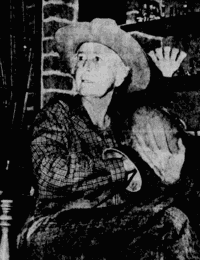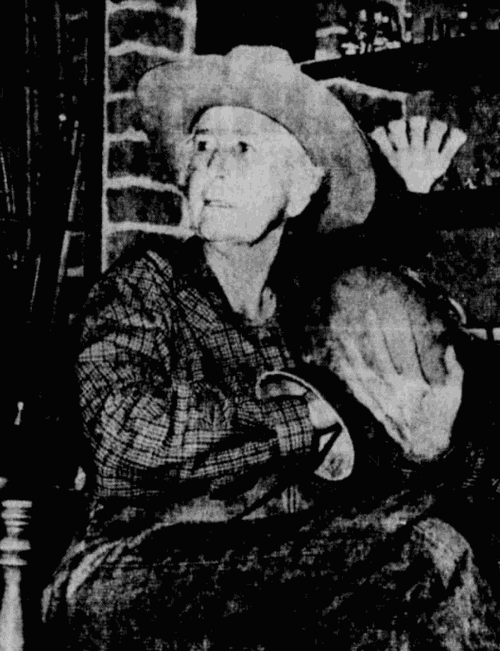According to Ila Harrison Healy, her ancestral lineage included two U.S. presidents, William Henry Harrison and his grandson, Benjamin Harrison, as well as one of the founders of the University of Arizona, Richard Morgan Harrison.
She also claimed that the country’s first Thanksgiving in 1619 was hosted at the Harrison ancestral home, Berkley, nestled along Virginia’s James River.
In 1982, Ila sat down for an extensive oral interview detailing her family history and her own incomparable life as a hunter, herpetologist, ornithologist, writer and lecturer.
Born to Charles and Ida Harrison on Feb. 4, 1900, Ila was one of 10 children. Charles worked as foreman for the Duquesne Mines and the family lived in nearby Washington Camp in the Patagonia Mountains. Ila considered her childhood idyllic as she roamed the hills surrounding her mountain home, wore shoes only when forced to do so and walked three miles to school.
Living in a wilderness area, Charles insisted his children learn to handle firearms. Ila became an expert shot and bagged her first deer at age 11.
She attended Tempe Normal School (now ASU) until her mother died in 1915, leaving the teenager to care for her five younger siblings. At age 18, when her older brothers enlisted during World War I, Ila took over for them at the mines. She ran air compressors, weighed ore, managed the manifest, ran the commissary and paid the workers. At the end of her shift, she went home and took care of the house and children.
Some nights, to earn extra money, she hauled ore from Lochiel, Arizona, to the railhead near Santa Cruz, Mexico. The extra income allowed her to go back to school at the University of Arizona though she did not graduate.
During these trips into Mexico, Ila met the infamous Pancho Villa, and found him “a fine man, well-liked along the border. I came to know him and his Villistas well,” she said. “He’d have his men unload my ore for me.”
In 1920, Ila married cavalryman John Hillard Healy (pronounced Haley) stationed with the 10th Cavalry at Fort Huachuca. Having no use for tea parties and bridge games, she started training the fort’s polo ponies and managed the Army’s polo team, a job she held until John retired in 1935.
One of the couple’s wedding gifts was a hunting excursion into the Huachuca Mountains. Ila killed her first mountain lion on this trip and would later claim to have bagged more than 19 during her lifetime.
During John’s stint with the Army, he was stationed in the Philippines for a couple of years. Ila went with him and was soon hunting local game — wild pigs. She also went after saladang — wild cattle — in Borneo, considered one of the most dangerous animals to pursue. During her lifetime, she also hunted bears and jaguars.
About two years after John retired, the Healys bought property in Carr Canyon, on the southern edge of the Huachuca Mountains. Trying to raise cattle, they were frustrated by losing many of their herd to mountain lions. Ila took out her trusty .30-30 Winchester or her .22 rifle and set out to protect the herd.
“I stampeded a ladies’ bridge party once when I rode into Ramsey Canyon Ranch with a live mountain lion tied over the front of my saddle,” she said. “I don’t know what they were so upset about. It was my hand the mountain lion had chewed when he came unmuzzled.”
Ila also had an affinity for capturing snakes, her interest piqued by a visit from Carl Kaulfield, curator of the Staten Island Zoo, who came to the mountains seeking particular species. Before long, Kaulfield and other herpetologists were writing Ila asking her help to locate certain snakes and ship them. “They’d ... say well we need a Willard or we need a blacktail rattler, or we need a green rock ... and when I’d run across a snake that I knew they wanted, I just ... caught it and dropped it in a sack and brought it home.”
Local groups often asked Ila to speak about her hunting experiences. On one occasion, she caught a harmless bull snake for a demonstration at the Bisbee Women’s Club. During the luncheon, she kept the snake beside her chair in a pillowcase where it remained subdued during the meal.
“I gave them a talk on snakes,” Ila said, “and they were very interested, listened to everything.”
She reached into the pillowcase to demonstrate how to handle a snake.
According to Ila, the snake “sort of came to life and he was hissing and wiggling and carrying on terribly. ... I really struggled for quite a while before I could get my snake out of the sack. So finally, I got the snake out, and I said, ‘And now,’ and I looked up, and there wasn’t a single woman in the club. There was not a soul in that auditorium. I put my snake back in my pillowcase and came home. I decided snakes weren’t a very good thing to talk about.”
Ila also took an interest in birds after ornithologist Herbert Brandt came to the ranch. For 11 years, she and Brandt identified birds in the Huachucas. In 1950, she collaborated with National Geographic Magazine on an article, “Flight of the Hummingbird.”
The Healys ran a guest ranch at Carr Canyon during the winter months. From May to October, however, Ila cared for asthmatic children. She never had children of her own.
The ranch became a sanctuary for an assortment of animals the children considered their personal pets. Ila raised a coatimundis from infancy, watched over a doe that considered the ranch a safe haven for its twin fawns and tolerated a buck that had a hankering for tobacco.
Ila died on Sept. 24, 1985. Few can compete with the woman who chased lions and snakes throughout the Huachuca Mountains.





